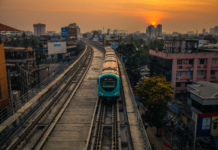Introduction
Mumbai, formerly known as Bombay, is the capital of Maharashtra and is situated along the Konkan coast adjacent to the Arabian Sea. It serves as the central hub of the Mumbai Metropolitan Region. The city is distinguished for its vibrant culture and diverse characteristics. Mumbai is recognized as India’s primary financial and commercial center, often referred to as the “Economic Capital of India”.
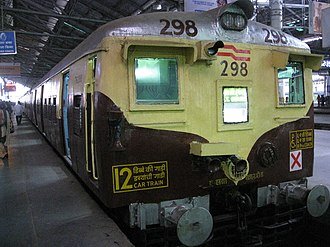
The Need for a Railway System in Bombay
In the early 19th century, Mumbai was evolving as a commercial and administrative center under the British East India Company. The city’s economy was heavily reliant on the port, textile mills, and trade industries, which led to a surge in the population of the city. In the absence of an efficient mode of transport, the British faced challenges in transporting the goods, workers and officials across the city’s surrounding regions.
To resolve this issue, the Britishers focused on developing a rail network that was heavily influenced by the Industrial Revolution in England. Known as the “Lifeline of Mumbai,” the Mumbai Suburban Railway has undergone over 120 years of evolution to meet the growing demand for efficient transportation solutions.
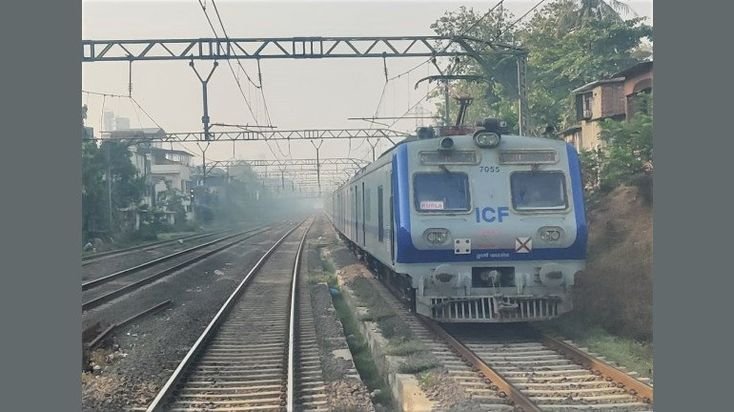
Advent of the First Railway Network in India
March 1840- The investors and British engineers proposed the idea of the railway network.
1 August 1849: The Great Indian Peninsula Railway Company was incorporated for the construction and operation of a 56km long rail line connecting Bombay to inland regions.
16 April 1853 – The first train was operated by the Central Railways ( formerly known as Great Indian Peninsula Railway) between Bori Bunder Chhatrapati Shivaji Maharaj Terminus (formerly known as Bori Bunder) and Thane, covering a distance of 34 km in 57 minutes. The train had three steam locomotives (Sahib, Sultan, and Sindh) and 14 carriages.
1855: The Bombay, Baroda & Central India Railway (BB&CI) was formed to construct and operate lines on the western side, facilitating travel between Bombay and Baroda.
April 1867: The Bombay, Baroda & Central India Railway (BB&CI) company started the inaugural operation of dedicated suburban trains between Virar and Bombay Backbay; later, it was extended to Churchgate in 1870.
3 February 1925 – The first EMU service started from Victoria Terminus to Kurla ( formerly known as Coorla Harbour) on the Central line.
5 January 1928 – The EMU service started on the Western line between Churchgate and Borivali.
1 January 1942: Bombay, Baroda & Central India Railway Company became part of the Indian State Railway system, directly under the Railway Board.
5 November 1951: The Great Indian Peninsula Railway Company was incorporated into the Central Railway
12 November 2007: Western Railways inaugurated the first of 129 new 12-coach trains equipped with enhanced facilities as part of the Mumbai Urban Transport Project.
21 November 2009 -To alleviate the problems of overcrowding,15-coach trains were introduced.
April 2014 – New Electrical Multiple Units (EMUs) featuring Bombardier technology, procured under the Mumbai Urban Transport Project-2, have commenced arriving in Mumbai.
5 April 2016 – The first air-conditioned rake built by Integral Coach Factory in Chennai–BHEL EMU at a cost of over ₹50 crore, ICF–BHEL arrived in Mumbai.
2016: The entire network of Mumbai Suburban Railways was converted to 25 kV 50 Hz AC traction.
25 December 2017 – The first AC local train began operation on the Western Railway.
6 November 2019 – The Uttam rake (5533-5536) of Mumbai Suburban Railways, which was manufactured by ICF, was introduced and operated on the Western Line.
30 January 2020 – The fourth AC rake and the first for Central Railway was commissioned on the Trans-Harbour Line from Thane to Panvel/Vashi.
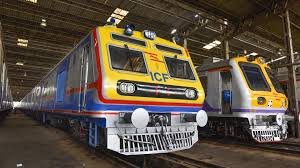
Mumbai Suburban Railways: The Lifeline of Mumbai
Mumbai Suburban Railways is the oldest railway network in Asia. Established in 1853, it is operated by the Central Railway (CR) and Western Railway (WR) zones of Indian Railways. Spanning approximately 450.6 kilometres, the Mumbai Suburban Railway network is the busiest in the world, serving over 7.06 million commuters on a regular basis. The Mumbai Suburban Railway Project consist of 7 corridors in total, out of which 5 corridors are currently operational and 2 corridors are under construction.
The normal capacity of each train during peak hours is 1,700 passengers; however, it is not uncommon for over 5,000 individuals to occupy these trains. Over the years, commercial activities in Mumbai have expanded, primarily due to the influx of population from neighboring states. As the commercial capital of India, Mumbai presents employment opportunities, which has resulted in a substantial migration of individuals from rural and semi-urban regions of the country.
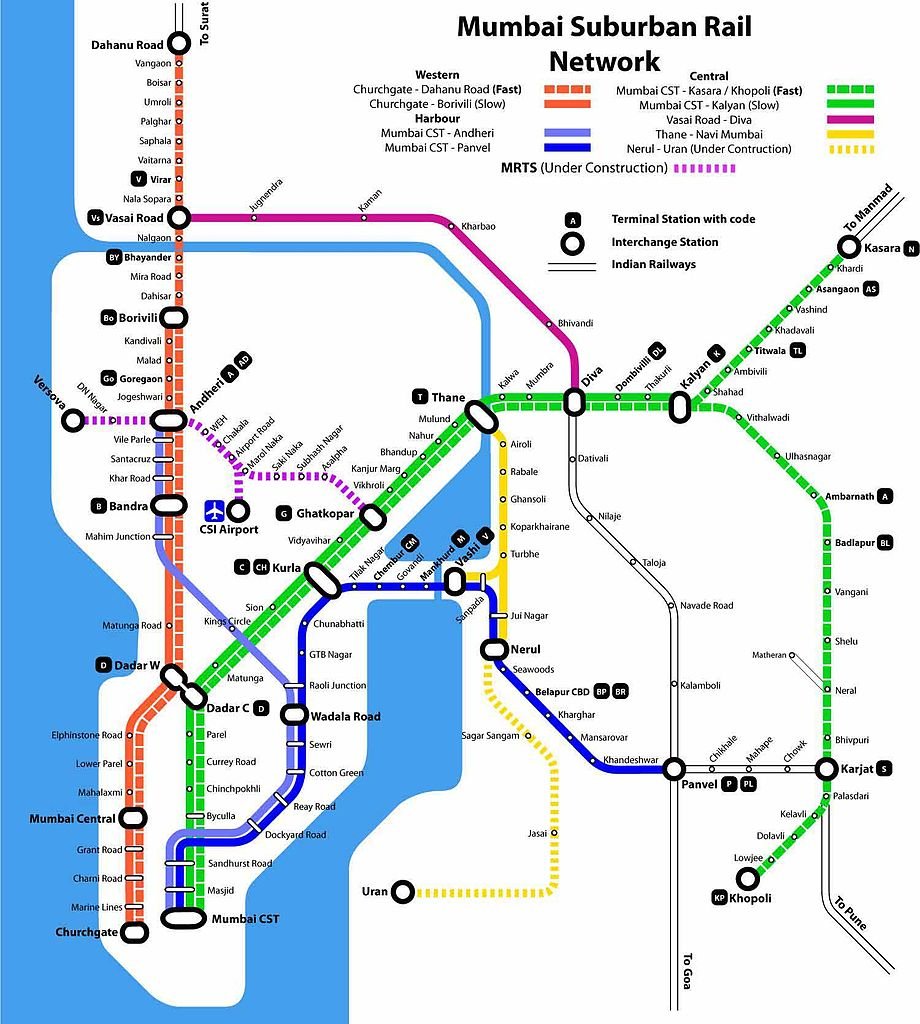
The Incorporation of Mumbai Railway Vikas Corporation (MRVC)
The Mumbai Railway Vikas Corporation (MRVC), established on July 12, 1999, is a public sector enterprise under the purview of the Ministry of Railways. MRVC is primarily responsible for implementing phases of the Mumbai Urban Transport Project (MUTP). Additionally, it aims to streamline suburban rail transportation by segregating the suburban train operation from the main line passenger and freight services.

Phases of Mumbai Urban Transport Project (MUTP)
Phase 1
The Mumbai Urban Transport Project (MUTP) Phase-1 was approved as part of the Railway Budget for the fiscal year 2003-04, with an initial estimated cost of Rs. 3,125 crore. This cost has since been revised to Rs. 4,174 crore. The project was successfully completed in June 2011. It was the first MUTP project to receive funding from the World Bank. The project involved the provision of 5th & 6th lines between Kurla and Thane (segregating long-distance and suburban trains) and a Harbour Line extension to Panvel for better suburban connectivity.
Phase 2
The Ministry of Railways has identified eleven projects under the Mumbai Urban Transport Project Phase II (MUTP), with an estimated budget of Rs. 3,502 crores. The work on Phase 2 started in April 2008 and is expected to be completed by March 2027.
Cost Escalations: The Mumbai Urban Transport Project Phase II (MUTP-II) has experienced a significant cost escalation since its initial approval.
| Cost Escalation in MUTP Phase II | Status | Remarks |
| Project Component | Initial Cost (₹ crore) | Revised Cost (₹ crore) |
| DC to AC Conversion (Central Railway) | 293 | 730 |
| Andheri-Goregaon Harbour Line Extension | 106 | 146 |
| 5th & 6th Lines (CST-Kurla) | 659 | 920 |
| 6th Line (Mumbai Central-Borivali) | 522 | 1,044 |
| Total Estimated Cost of MUTP-II | 5,300 | 7,300 |
As of March 2025, the status of the Mumbai Urban Transport Project (MUTP) Phase II components is as follows:
| Project | Status |
| Thane–Diva Additional Pair of Lines | Completed |
| Extension of Harbour Line to Goregaon | Completed |
| Kurla–Chhatrapati Shivaji Terminus 5th & 6th Lines | Ongoing |
| Mumbai Central–Borivali 6th Line | Ongoing |
| Bandra–Kurla (East-West Link) | Ongoing |
| Diva–Kalyan Additional Pair of Lines | Ongoing |
| DC to AC Conversion (Thane–CST) | Ongoing |
| Signalling & Telecom Upgradation | Ongoing |
| EMU Maintenance Facilities and Stabling Lines | Ongoing |
| EMU Procurement, Manufacture, and Retrofitment | Ongoing |
Phase 3
MUTP Phase 3 was approved by the Indian government in December 2016 with an estimated cost of ₹10,947 crore. It is jointly funded by Indian Railways and the Government of Maharashtra through the Mumbai Railway Vikas Corporation (MRVC), with about ₹3,500 crore in financial assistance from the Asian Infrastructure Investment Bank (AIIB).
| Project Component | Details | Estimated Cost (₹ crore) |
| Virar-Dahanu Quadrupling | Addition of 2 new lines for long-distance and suburban trains | 3,555 |
| Airoli-Kalwa Elevated Link | New suburban railway corridor for better connectivity | 476 |
| Panvel-Karjat Suburban Corridor | Extension of suburban services to Karjat, reducing travel time | 2,782 |
| Procurement of AC EMUs | 47 new AC local train rakes | 3,491 |
| Station Modernization & Infrastructure Upgrades | Upgrades to platforms, FOBs, and improved passenger amenities | 693 |
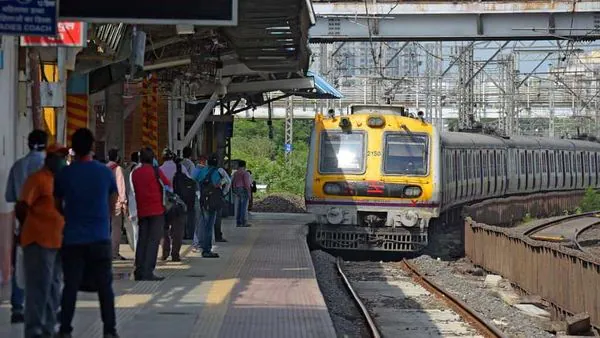
Current Status of MUTP Phase 3
| Project | Current Status |
| Virar-Dahanu Quadrupling | 33% work completed |
| Panvel-Karjat Corridor | 67% work completed. |
| Airoli-Kalwa Link | 46% work completed |
Recent Update
Central Approval for 238 Local Trains
In March 2025, the central government approved the acquisition of 238 local air-conditioned (AC) trains for the Mumbai Suburban Railway. The Mumbai Urban Transport Project (MUTP) Phase 3 plans to secure 47 AC local trains at an estimated expenditure of ₹3,491 crore, whereas MUTP Phase 3A is projected to procure 191 AC trains at a total cost of ₹15,802 crore.
Operational Lines of Mumbai Suburban Railway
1. Central Line
The Central Line of Mumbai Suburban Railways consists of 3 major corridors. The main corridor runs between Chhatrapati Shivaji Maharaj Terminus and Kalyan. It then subsequently splits into two corridors. One corridor operates in the northeast part, while the other runs in the southeast part of Mumbai. The Central Line is managed and operated by Central Railways.
| Corridor | Route | Length |
| Central Line | Chhatrapati Shivaji Maharaj Terminus – Kalyan | 55 Km |
| North-East Line | Kalyan – Kasara | 67 Km |
| South-East Line | Kalyan – Khapoli | 61 km |
2. Western Line
The Western Line of Mumbai Suburban Railways consists of one corridor which spans 124 km from Churchgate to Dahanu Road through 37 Stations. The Western Line is managed and operated by Western Railways.
| Corridor | Route | Length | Total no. of Stations |
| Western Line | Churchgate – Dahanu Road | 124 Kms | 37 stations. |
3. Harbour Line
This Line began operations on December 12, 1910. The Harbour Line of Mumbai Suburban Railways is operated by Central Railways. It primarily serves the eastern suburbs of Mumbai and the fast-developing Navi Mumbai region, providing essential connectivity to residential, commercial, and industrial hubs. Unlike the Central and Western lines, the Harbour Line has a separate track system between CSMT and Panvel.
| Corridor | Route | Length |
| Main Line | Chhatrapati Shivaji Maharaj Terminus – Wadala Road – Panvel | 53.32 km |
| Extended Route | CSMT-Wadala Road – Andheri- Goregaon | 43.55 km |
4. Trans- Harbour Line
The Trans-Harbour Line serves as a branch corridor of the Harbour Line. The line provides direct connectivity between Thane and Navi Mumbai. Its role is significant in decongesting the harbour line and central line. It offers an alternative route for the commuters who are traveling between Thane, Vashi, Nerul and Panvel. This line also supports the freight movement in Taloja and Jawaharlal Nehru Port Trust (JNPT).
| Corridor | Route | Length |
| Trans-Harbour Line | Thane – Vashi/Nerul | 23.36 km |
| Nerul – Panvel | 16.10 km |
5. Vasai Road–Roha Line
The Vasai Road – Roha Line of Mumbai Suburban Railway connects the Western line, Central line and Harbor line of the Western Railway zone and Central Railway zone. This Line consists of one corridor which operates between Vasai Road and Roh, covering 23 stations. Central Railway operates and manages this line.
| Corridor | Route | Length | Total no. of Stations |
| Corridor 1 | Vasai Road – Roha | 101 km | 23 Stations |
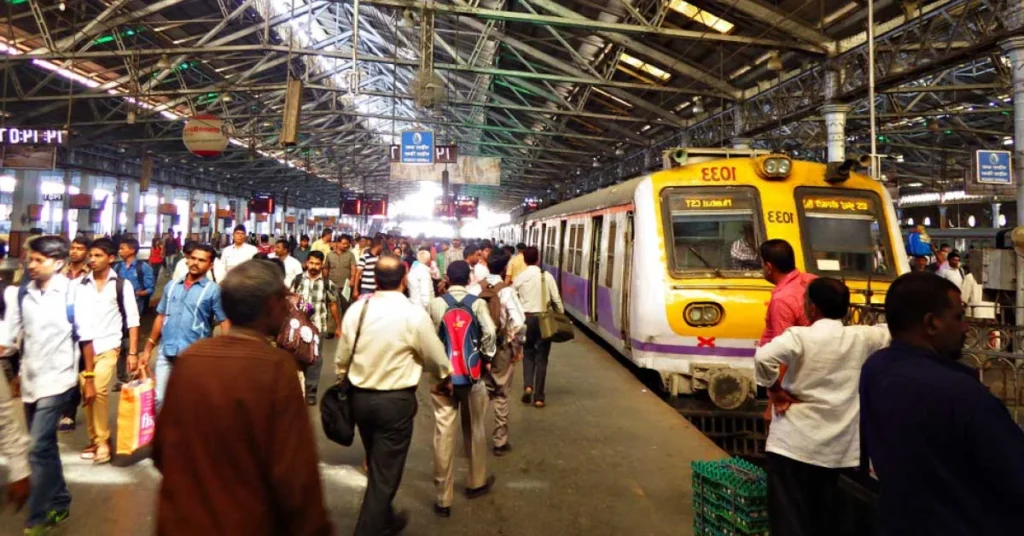
Under Construction Lines of Mumbai Suburban Railways
Port (Nerul–Uran) Line
The Nerul–Uran line, commonly referred to as the Port line, serves to connect Navi Mumbai with Uran. This railway infrastructure is poised to facilitate the accelerated development of Navi Mumbai, the Jawaharlal Nehru Port, and the recently established areas of Mumbai. The construcion of this line is being carried out in 2 Phases:
- Phase I: Bamandongari and Kharkopar stations operational; Targhar station under construction.
- Phase II: Stations between Kharkopar and Uran completed and inaugurated on January 12, 2024.
| Corridor | Route | Length |
| Port (Nerul–Uran) Line | Nerul–Uran | 22.5 km |
Panvel-Karjat Line
The Panvel-Karjat Railway Corridor is a suburban railway infrastructure project under the Mumbai Urban Transport Project (MUTP-III). The Panvel-Karjat line spans a 29.6-kilometer corridor and is being developed by the Mumbai Rail Vikas Corporation (MRVC). This line will be operated by the Cenral Railways.
| Corridor | Length | Total no. of Stations |
| Panvel-Karjat | 29.6 km | 5 Stations |
Recent Updates on the Mumbai Suburban Railways Project
| 1. Upgraded EMU Rakes Ashwini Vaishnaw, the Minister of Railways, recently announced that the Mumbai suburban railway system is set to receive upgraded electric multiple unit (EMU) rakes, which will feature enhanced ride quality and ventilation comparable to that of the Vande Bharat Express. Minister Vaishnaw indicated that the designs for these modern rakes are currently under development. 2. Expansion of Suburban Train Services Minister Ashwini Vaishnaw also stated that Indian Railways is planning to increase the number of suburban train services by a minimum of 10%, expanding from the existing 3,000 daily services. |
Significance of Mumbai Suburban Railways
1. Affordable Public Transport: The Mumbai Suburban Railway offers one of the most economical modes of commuting within the city, ensuring accessibility for individuals from diverse economic backgrounds. The affordable ticket prices provide substantial financial savings compared to alternative modes of transportation, such as taxis and private vehicles.
2. Reduction in Traffic Congestion: By accommodating over 7.5 million passengers on a daily basis, the Mumbai local trains play a crucial role in reducing the traffic on the roads of the city. The extensive network of Mumbai Suburban Railways reduced the dependency of residents on private vehicles by providing them with a more efficient and affordable mode of public transportation.
3. Enhanced Connectivity: The vast network of Mumbai Suburban Railways ensures connectivity between all major commercial and residential areas of the city. The Mumbai local trains provide the residents of Mumbai with a more convenient and affordable mode of public transport.
4. Boost to Economic Growth: The suburban railway is integral in supporting daily wage workers, office employees, and small business owners by providing a dependable commuting alternative. The extensive network encourages business establishments to develop offices throughout the city, thus contributing to overall economic growth.
5. Multi-Modal Connectivity: The lines of Mumbai Suburban Railway seamlessly connects with other modes of transportation in the Mumbai Metropolitan Region (MMR), including Mumbai Metro, Mumbai Mono Rail, Buses and Railway to facilitate the smooth flow of commuters.
Limitations in the Mumbai Suburban Railway Project
1. Aging Infrastructure: The ageing infrastructure of the Mumbai Suburban Railways is a major concern for Indian Railways. The outdated infrastructure of local trains has not been able to keep pace with the growing population and demand. For Example, Many railway tracks are over 50 years old, leading to frequent wear and tear. This raises concerns regarding the safe operations and passengers’ safety.
2. Capacity Constraints: The increase in suburban train services in Mumbai has also not kept pace with the rising passenger demand, which has led to overcrowding in existing trains. As a consequence, traveling conditions for commuters have become increasingly challenging. A substantial number of individuals rely on suburban trains due to the lack of affordable alternative transportation options. Despite catering to over 7.5 million commuters regularly, Indian Railways is facing considerable difficulties in managing the escalating passenger volume.
Conclusion
Mumbai Suburban Railway has played a crucial role in shaping the city’s urban mobility since its inception in 1853. Spanning approximately 450.6 km, it remains the busiest railway network, serving over 7.06 million commuters daily. The introduction of AC local trains, MUTP phases, and network expansions like the Virar-Dahanu and Panvel-Karjat corridors highlight continuous modernisation efforts. Despite challenges like overcrowding (where trains carry up to 5,000 passengers per trip), projects under MUTP Phase 3 and 3A aim to enhance efficiency and commuter experience, securing Mumbai’s transportation future.





